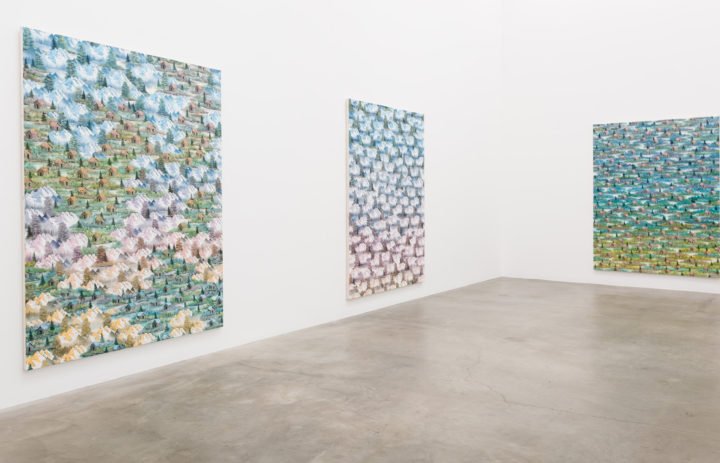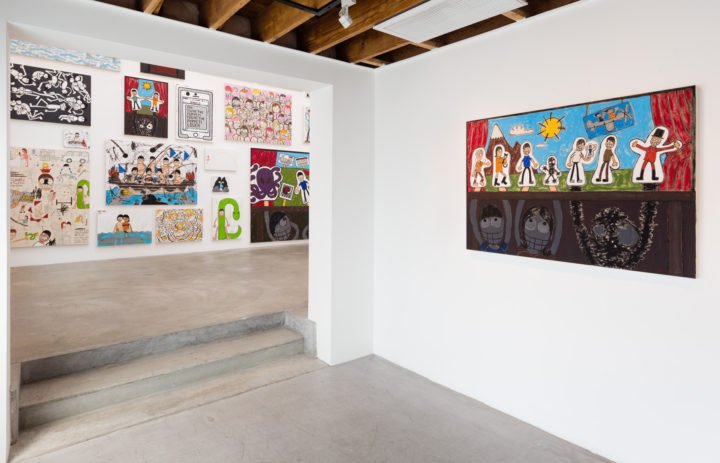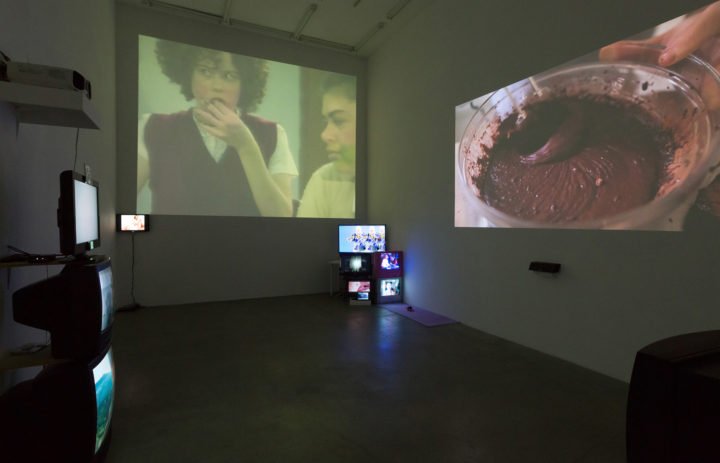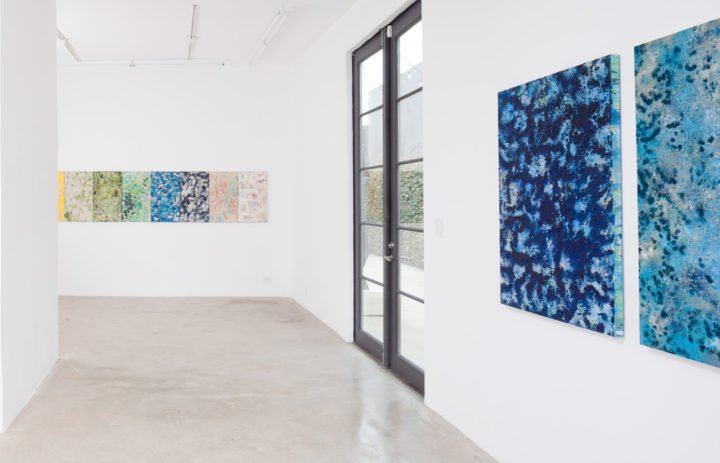- Address: 2660 S La Cienega Blvd, Los Angeles, CA 90034
- Owner: Anat Ebgi
Anat Ebgi (A): Our gallery spaces are comprised of two nearby locations on La Cienega Blvd, one at 2660 S La Cienega and the other just a few doors down at 2680 S La Cienega. Both were automotive shops before being repurposed as exhibition spaces – 2660 has been the main location for Anat Ebgi since 2012, and was expanded in 2013 to incorporate a larger exhibition space. We’ve recently opened a new space at 2680 in Spring 2017 to host complementary exhibitions alongside the main space.
I think what makes the main gallery space so unique is twofold. The height of the ceiling is close to 20 feet, so visitors often don’t see or feel constrained by any notion of a ceiling – for them the art on view exists in a solemn, almost religious context. Adding to this is the lighting. The gallery uses a combination of florescent and natural lighting, which, when combined with the ceiling height, offers gallery shows to be seen with a welcoming clarity.
A: I moved to Los Angeles from New York in 2008 when the art market was in serious decline and many galleries were shutting their doors and museums were letting go of staff. For me it was an important time to reconnect with young, emerging artists and discover new practices tied to time-based formats such as performance and video, a focus of my studies at CCS Bard. Out of these experiences I organized and curated a number of shows and eventually felt like it was time to open my own gallery to further the opportunities for a close group of artists, focusing precisely on developing a roster of artists who embrace a concept of labor and materiality in their work.
A: Truly every gallery is unique, and that can’t be overstated since gallery work is so intensely personal and nuanced. I would say that, in my own experience, I have worked hard to incorporate a diverse group of artists that come from Los Angeles, New York and are based internationally that share common ideas about how to approach a body of work and invest a sense of rigor in their practice. Aside from that I always emphasize the position of the artist above all else in regards to their relationship with the gallery, and let them find how to best express their work within the gallery.
A: Aside from the focus on artistic practice and rigor, I also think it is important not to shy away from pertinent political and social topics, but rather find ways to have work that critically embraces the moment. This could be in bodies of work that address race, class, feminism or social justice, expressed in ways that are not forced but rather embedded within the curation and practice of participating artists.
A: Los Angeles is certainly one of a kind not only on the West Coast but in the country. I think that in the time I have lived in L.A., there has finally been an understanding that the city’s place as an artists’ city is maturing, and new museums, galleries and institutions actively celebrate this aspect of the city. What I’ve always appreciated most is the ability for an artist to show work at a smaller scale, perhaps a project space for example, and work their way through the diverse community of curators, gallerists and collectors that are deeply interested in new artists and their work. There is not a bias against new artists here but rather a profound embrace of them.
A: I think many people have a misconception that gallerists are masterminds of obscurity and opacity, and hold somewhat of an exclusionary distance to the public. This couldn’t be further from the truth. While there is a lot of scrutiny in the curation process, it is simply out of the desire to present the very best body of work for an artist. It takes months to plan out and execute a successful exhibition, with often over a year of pre-planning. When it comes down to the line you only have a specific period in time for exhibition to succeed or fail, and this precariousness makes being a gallerist that much more exciting but also challenging on an ongoing basis.
A: An Te Liu’s show that opens on June 9 is of particular importance to me. We’ve been working with the artist for over a year now and his practice exemplifies what I look for in an artist. Liu is a Canadian sculptor whose pieces have a totemic yet modern presence, and are made in such a careful, exacting manner. Outside of that I am also looking towards Neil Raitt’s second solo show at the gallery opening in September that will be his first since moving to Los Angeles earlier this year.
A: In terms of working with new artists, I attend studio visits frequently seeking to evaluate an artist’s underlying conceptual grounding with their methods and practice. There needs to be a clear relationship between what an artist says they are doing and what they are actually producing, too much emphasis on either side of that dynamic and the work begins to suffer. I am the most intrigued when I feel that an artist has mastered a specific line of material and conceptual inquiry and can form mature bodies of work from this dialogue.
A: Show as much as you can! I keep seeing artists who treat exhibition opportunities with a lot of hesitation and soul-searching, but really you can’t get your work out in the world unless it’s being seen by others in a public setting. From these exhibitions, conversations may start to begin that leads an artist to studio visits and potential relationships with gallerists. Art is a corporeal experience and needs to be understood as such.
A: I really have no preference. Art education is something used to sharpen and help refine the ability of an artist to make self-critical decisions in regards to their own practice. In certain instances, artistic vision and success is not derived from the traditional MFA model. That being said, the ability to learn theory, concepts and a sense of self-discipline that studio programs offer is essential for any artist to be successful in regards to developing their own practice and working with a gallery.
A: The internet and digital media have greatly transformed the gallery landscape. Decisions to collect and means of publicizing shows and artists are much faster now. I would anticipate that digital means will continue to transform the pace and accessibility to art and galleries, but I would also argue that the core of the gallery, the relationships between gallerist and artists, will not change. I’ve been reading into the early Los Angeles scene of the ’60s and it’s so interesting to see how similar galleries like Ferus or Nick Wilder supported their artists in essentially the same ways they do now. At the end of the day it’s all about the ability to host a space that connects artists with a wider critical, collecting and institutional community.
- Featured image on the top: Transmission by An Te Liu – 2017
- Photos courtesy of Anat Ebgi









